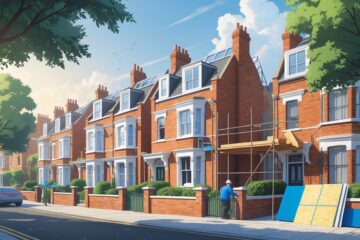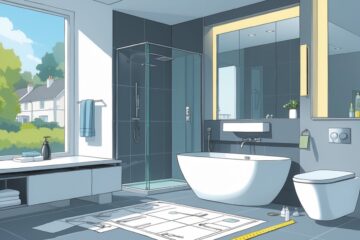Restoring a Victorian home can be a rewarding endeavour that reflects its rich history and unique architecture. Preserving and enhancing original features not only maintains the character of the property but also adds significant value. Many homeowners are eager to breathe new life into their spaces, yet they may feel overwhelmed by the process.
Attention to detail is crucial when reviving elements like decorative cornices, fireplaces, and door frames that typify Victorian design. Understanding the unique characteristics of the Victorian era can inspire a more authentic approach to decoration and renovation. Effective preparation and planning ensure that each feature is restored to its former glory while complementing modern living needs.
Emphasising light and bright interiors can dramatically transform a Victorian home, making it feel welcoming and spacious. By skillfully blending original features with contemporary touches, homeowners can create a harmonious living environment. With the right techniques and insights, a Victorian house can become a perfect blend of the past and present.
Key Takeaways
- Focusing on original features enhances the charm and value of Victorian homes.
- Knowledge of Victorian architecture guides restoration efforts effectively.
- Strategic decorating can harmonise historical elements with modern living.
Understanding Victorian Architecture
Victorian architecture is characterised by a rich variety of styles and decorative elements that reflect the aesthetics and societal values of the period. Key features include high ceilings, large windows, and thick walls, which contribute to the grandeur often associated with these homes.
Defining Victorian Aesthetics
Victorian aesthetics combine numerous styles, including Gothic Revival, Italianate, and Queen Anne, each contributing unique architectural features. Distinctive elements such as ornate cornices, intricate woodwork, and vibrant colour schemes define the period.
Victorian homes frequently showcase high ceilings that create a sense of spaciousness. Large windows, often adorned with elaborate frames, allow abundant natural light, enhancing the home’s inviting atmosphere. Decorative elements, from patterned tiles to stained glass, play a vital role in reflecting the craftsmanship and artistic trends of the era.
Significance of Period Properties
Period properties hold cultural and historical significance, illustrating the architectural evolution of the Victorian era. They serve as tangible connections to the past, representing societal values such as family life and industrial advancement.
Owning a Victorian home often comes with the responsibility of maintaining its unique character. Preserving original features like fireplaces, decorative architraves, and ceiling roses is essential for retaining authenticity. This care not only honours the heritage of the property but also enhances its value in the modern real estate market. Restoring these features can attract homebuyers who appreciate historical charm and craftsmanship.
Preparation and Planning for Restoration
Proper preparation and planning are vital for a successful restoration project. This stage includes understanding legal requirements and establishing a solid project management framework.
Securing Planning Permission
Before starting any restoration work on a Victorian home, it is essential to check whether planning permission is needed. Many features, especially those of historical significance, may fall under local conservation rules.
Owners should contact their local council to determine specific requirements. Filling out the correct forms and submitting detailed plans are crucial steps. Gathering supporting documents, such as photographs and a description of the planned work, can help expedite the process.
He or she should be aware that failure to obtain necessary permissions may lead to fines or the requirement to undo alterations.
Project Management Essentials
Effective project management is crucial for restoring original features without complications. An initial step is to outline a clear timeline and budget. Creating a list of required materials and contractors allows for better tracking of expenses.
Regular meetings with contractors and suppliers can ensure everyone remains on the same page. It’s beneficial to set milestones to monitor the project’s progress. This method helps identify issues early.
He or she should also maintain a contingency fund for unexpected expenses, which are common in renovation projects. Strong project management keeps the focus on restoring the home’s charm while avoiding unnecessary delays.
Reviving Interior Features
Reviving the interior features of a Victorian home involves careful attention to the unique elements that define its character. This includes meticulous restoration of original architectural features, ensuring they retain their historic charm while meeting contemporary standards.
Restoring Sash Windows
Sash windows are iconic in Victorian architecture but often suffer from issues such as rot and draughts. The restoration process typically starts with a thorough inspection to assess the extent of damage.
In many cases, it may be possible to repair individual components rather than replace the entire window. Key steps include:
- Removing the Sashes: Carefully take the sashes out for better access.
- Repairing or Replacing Rotted Wood: Use epoxy or wood fillers for minor damage; replace sections for significant issues.
- Repainting: Use breathable, mould-resistant paint to protect the wood.
- Installing Draught Proofing: This enhances energy efficiency without compromising aesthetics.
Restoring sash windows not only improves appearance but can also significantly enhance warmth and energy performance.
Refurbishing Fireplaces and Plasterwork
Fireplaces served as the heart of Victorian homes, and many still retain intricate designs. Refurbishment should focus on both aesthetics and safety.
For the fireplace:
- Clean and Assess: Remove soot and debris to evaluate the condition.
- Repairing the Surround: Use reproduction tiles if necessary, ensuring they match historical patterns.
- Updating Flues: This step is crucial for safety before using the fireplace.
Plasterwork restoration involves:
- Assessing Cracks and Damage: Minor cracks can often be filled with plaster.
- Re-sculpting: Hire a professional for intricate plaster features.
- Repainting: Use traditional colours that reflect the home’s history.
Refurbishing both elements enhances interior design and retains the home’s original charm.
Preserving Stained Glass Windows
Stained glass windows are a key feature, often adding personality to a Victorian home. Preservation is essential, as they can be both delicate and valuable.
Key actions for preservation include:
- Inspection: Examine the glass for cracks or breaks.
- Cleaning: Use a soft, non-abrasive solution to remove grime.
- Releading: If the leading is compromised, consider professional repair.
- Sealing: Apply a protective coating to prevent moisture damage.
Maintaining stained glass windows not only preserves beauty but can also add value to the property over time. Each step requires precision to ensure the integrity and character of these features remain intact.
Strategic Home Extensions
Incorporating extensions into a Victorian home can enhance space while maintaining its character. These modifications should seamlessly blend with the original architecture, providing functionality without sacrificing aesthetic appeal.
Enhancing Space with Loft Conversions
Loft conversions are an effective way to utilise otherwise wasted space. They not only add valuable square footage but can also provide stunning views of the surrounding area.
When considering a loft conversion, it’s crucial to consult with an architect to ensure structural integrity. A well-executed conversion should complement the existing design. Options include creating a master bedroom, an office, or even a playroom.
Thoughtful design can incorporate skylights and dormer windows, maximising natural light. Additionally, building regulations must be adhered to, ensuring the finished space is both safe and compliant.
Side Return and Rear Extensions
Side return and rear extensions can significantly increase living space in Victorian homes. A side return extension involves building into the narrow side passage of a property, while a rear extension expands the back of the house.
These extensions can create open-plan living areas that connect seamlessly with gardens. They are ideal for kitchens or dining spaces, fostering a more social environment.
Materials should be chosen carefully, ensuring they align with the Victorian aesthetic. Glass bi-fold doors are popular, blurring the lines between indoors and outdoors. Each extension should consider natural light and garden views for an inviting atmosphere.
Considering a Wraparound or Basement Extension
Wraparound extensions combine both side and rear extensions, offering ample space. This approach is particularly beneficial for homeowners seeking an extensive living area without compromising the garden.
Basement conversions present an alternative for those with limited space. These projects can transform dark, unused spaces into vibrant areas such as home gyms or guest suites.
Both options require careful planning and consideration of local regulations. Employing a structural engineer is essential to assess feasibility and integrity. Whichever extension is chosen, it should maintain the harmony of the original Victorian architecture while providing modern conveniences.
Final Touches for a Light and Bright Home
Creating a light and bright atmosphere in a Victorian home can be achieved through careful selection of decorative elements. Focus on using light colours for walls and ceilings. Soft whites, pale greys, and pastel shades reflect natural light effectively.
Incorporating mirrors is another smart choice. They can enhance brightness by reflecting light from windows.
Consider the following decorative elements to finalise the renovation:
- Light Furniture: Choose pieces that are light in colour and material. This can help to open up spaces.
- Textiles: Opt for airy fabrics like linen or sheer materials for curtains. This allows light to filter through while maintaining privacy.
- Lighting Fixtures: Install stylish light fixtures that blend modern design with Victorian charm. Pendant lights and wall sconces can add elegance and brightness.
- Artwork: Hang light-themed artwork or black-and-white photographs that don’t overwhelm the space.
Accessorising with plants can bring life to a room. Select greenery that thrives in indirect light to enhance air quality and overall aesthetics.
Sheer rugs can add warmth without making the space feel heavy. The combination of these elements creates a cohesive look that maintains the original character while ensuring a fresh, bright environment.





